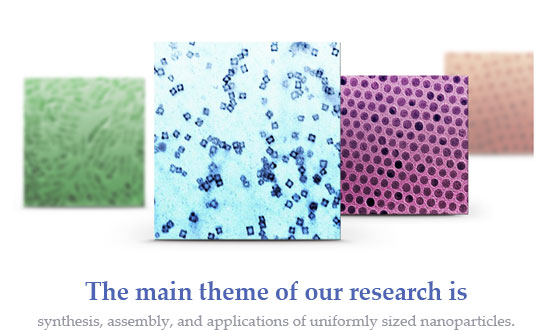mainmenu
Research
Prof.Taeghwan Hyeon
Synthesis and application of nanocrystals

The main theme of our research is synthesis, assembly, and applications of uniformly sized nanoparticles. In particular, we developed a generalized synthetic procedure, called "heat-up process," to produce uniformly sized nanoparticles of many transition metals, oxides and semiconductor without a size selection process. The synthesized nanoparticles include metals (Fe, Cr, Cu, Ni, Pd, and Ni/Pd core/shell), metal oxides (γ-Fe2O3, Fe3O4, CoFe2O4, MnFe2O4, NiO, and MnO) and semiconductors(CdSe, ZnS, ZnO, TiO2, CdS, BiTe and BiS). Using the heat-up process, large-scale (tens of grams) synthesis of monodisperse nanocrystals of magnetite and MnO from the thermolysis of metal-oleate complexes was achieved.
This heat-up process is now popularly used to synthesize uniformly sized nanocrystals of various materials. We also used non-hydrolytic sol-gel reactions to synthesize various transition metal oxide nanocrystals including ZrO2 nanocrystals, Sm2O3 nanobeams, CeO2 nanowires, ZnO nanorods, FeOOH nanotubes, and TiO2 nanorods. Our recent research is more focused on designed fabrication of multifunctional nanostructured materials based on uniform nanoparticles and their bio-medical and energy applications. For example, we developed a new T1 MRI contrast agent using manganese oxide (MnO) nanoparticles, exhibiting detailed anatomic structures of mouse brain.
Our group reported on the fabrication of monodisperse magnetite nanoparticles immobilized on uniform pore-sized mesoporous silica spheres for simultaneous MRI, fluorescence imaging, and drug delivery. We synthesized uniform 80 nm-sized ferrimagnetic iron oxide nanocubes and used them for T2 MRI contrast agent for tracking transplanted pancreatic islet cells and single-cell MR imaging. We synthesized hollow magnetite nanocapsules and successfully demonstrated their applications for MRI contrast agent and magnetically guided drug delivery vehicle. This hollow iron oxide nanocapsule was also used for anode of lithium ion battery. Another active area of current research is the synthesis of semiconductor nanoparticles for thermoelectric applications.
We have developed the inexpensive preparation method for efficient Bismuth (Bi) nanocrystals by engineering the size of the individual particles. Bi nanocrystals synthesized by a simple colloidal synthesis method exhibited very high electrical conductivity and extremely low thermal conductivity, which combines to increase thermoelectric efficiency.


